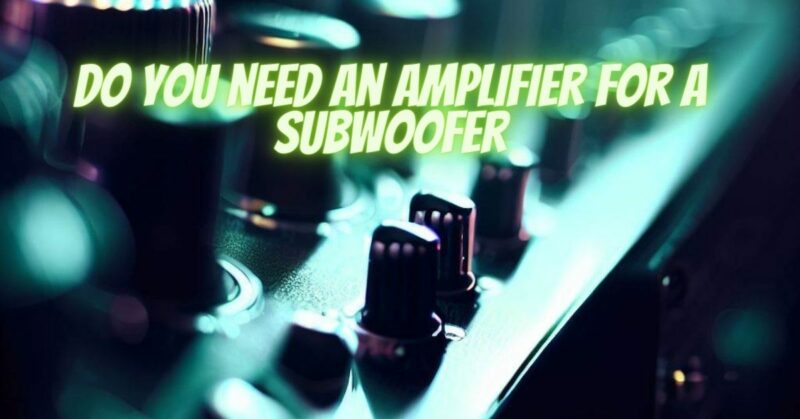Subwoofers are essential components of many audio systems, adding depth and impact to low-frequency sound reproduction. One common question that arises is whether a separate amplifier is required to power a subwoofer or if it can be driven directly from a receiver or amplifier. This article explores the role of amplification in subwoofer setups, the different types of subwoofers, and considerations for achieving optimal bass performance.
Understanding Subwoofer Amplification
- Passive vs. Powered Subwoofers:
- Passive Subwoofers: Passive subwoofers require an external amplifier to provide power to the speaker. They do not have built-in amplification and rely on an external source for power.
- Powered (Active) Subwoofers: Powered subwoofers, also known as active subwoofers, feature a built-in amplifier and require only a line-level input signal from a receiver or preamplifier. They are self-contained units that do not need an external amplifier.
- Amplifier Requirements:
- Power Rating: When using a passive subwoofer, the amplifier must have sufficient power output to drive the subwoofer effectively. The power rating of the amplifier should match or exceed the subwoofer’s recommended power handling capabilities.
- Low-Frequency Output: Subwoofers require amplification specifically designed to reproduce low-frequency signals effectively. Amplifiers with dedicated subwoofer outputs or subwoofer crossover settings are often preferred for this purpose.
Considerations for Subwoofer Setup
- Room Size and Acoustics:
- Bass Response: The size and acoustics of the listening room can significantly impact the performance of a subwoofer. Larger rooms may require more powerful amplification to fill the space with deep, impactful bass.
- Placement: Proper placement of the subwoofer within the room is crucial for achieving optimal bass response. Experimentation with placement and room correction tools can help mitigate room modes and optimize bass distribution.
- Integration with Existing Audio System:
- Receiver Compatibility: Many modern AV receivers and stereo amplifiers feature dedicated subwoofer outputs or preamp outputs, making it easy to connect a powered subwoofer directly without the need for a separate amplifier.
- Crossover Settings: Adjusting crossover settings on the amplifier or receiver ensures that the subwoofer reproduces only the low-frequency signals intended for it, preventing overlap with the main speakers’ frequency range.
- System Configuration and Expansion:
- Multi-Sub Setup: In larger rooms or critical listening environments, multiple subwoofers can provide smoother bass response and better room coverage. Each subwoofer may require its own amplifier or dedicated channels on a multi-channel amplifier.
- Bi-Amping or Tri-Amping: Advanced setups may involve bi-amping or tri-amping the main speakers and subwoofers separately, requiring additional amplification channels and careful calibration for optimal performance.
Advantages of Powered Subwoofers
- Simplified Setup: Powered subwoofers offer a plug-and-play solution, eliminating the need for a separate amplifier and simplifying the setup process.
- Integrated Amplification: The built-in amplifier in powered subwoofers is specifically matched to the speaker, ensuring optimal performance and minimizing compatibility issues.
- Remote Control and Adjustability: Many powered subwoofers come with remote controls and built-in controls for volume, phase, and crossover settings, allowing for convenient adjustment and optimization of bass performance.
Whether you need a separate amplifier for a subwoofer depends on the type of subwoofer you have and your existing audio system setup. Passive subwoofers require an external amplifier to provide power, while powered subwoofers have a built-in amplifier and can be connected directly to a receiver or amplifier. Considerations such as room size, amplifier compatibility, and desired bass performance should guide your decision when choosing between passive and powered subwoofers. Ultimately, the goal is to achieve a well-integrated and balanced audio system that delivers immersive and impactful bass reproduction for an enjoyable listening experience.

